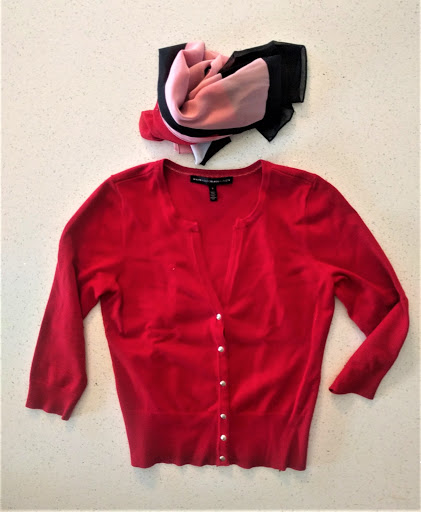Confession
I don't buy 100% of my clothing at Goodwill. For example, I generally purchase my shoes new (although I've gotten some good pairs at Goodwill in the past).
However, when I DO purchase new, I'm frequently disappointed because I don't follow my own rules.
A couple of years ago, I purchased a red cardigan sweater with matching scarf at White House Black Market:
I don't remember exactly what I paid, but I found a similar cardigan in their online store for $39.99, and a similar scarf for $19.99. Not pictured, but included in the purchase, was a white camisole that tied everything together - say another $19.99, for a total of - $78.98 (a lot more than I paid for my entire summer wardrobe).
They all looked great in the dressing room, and I already had in mind the trousers and skirts I could wear with these new items. I also had some black tops I was hopeful I could wear beneath the cardigan.
However, once I got all of the clothing home, I only wore the new outfit once. Whenever I tried the sweater and the scarf together, I looked like a flight attendant (no offense against flight attendants, but I needed a different look). I couldn't get the sweater to go with my more professional black tops, and a sweater and camisole combination without the scarf made me look like a character from the musical, "Grease" - not exactly an appropriate look for a financial advisor!
Rules Violated
I didn't start with Goodwill.
I reasoned that I was in a hurry, and that I needed some pieces with professional "finish" that I couldn't count on with used clothing. So I skipped shopping at my local Goodwill where I might have found exactly what I wanted at one fourth the cost.
I purchased three things at once.
When I shop at Goodwill, I generally purchase only one or two items at a time, I make sure they integrate into my existing wardrobe, and then I decide if there is another piece I want that will then tie the new piece to other existing pieces (like a scarf). In this case, my sweater did NOT integrate into my wardrobe at all, so purchasing two more items just compounded the mistake.
I focused on the individual piece instead of how it looked on me.
This third violation is a bit more subtle, but I find that I fall prey to it more often at upscale boutiques compared to Goodwill. I'll tend to focus on the beauty or quality of the piece rather than focusing on how it actually looks on me. I don't doubt that there are plenty of women who could wear the sweater and scarf pictured above and look fantastic. I'm not one of those women.
Hopefully, I've learned my lessons for next time!

Comments
Post a Comment